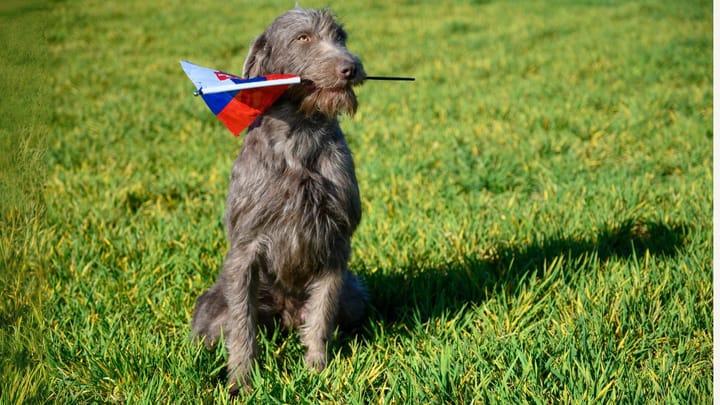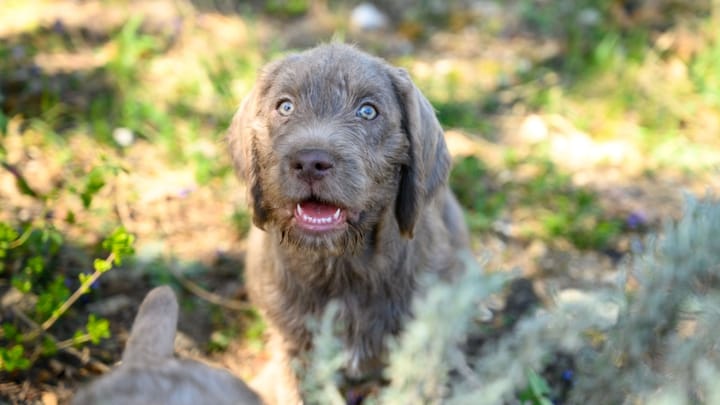Wirehaired Slovakian Pointer
Other names : Slovensky Hrubosrsty Stavac, Slovensky Hrubosrsky (Ohar), Slovakian Wirehaired Pointing Griffon, Slovak Rough-haired Pointer


Originating from the Czech Republic and a very recent addition to canine breeds in the UK. The Slovak Rough-haired Pointer is a large dog built to point, hunt and retrieve game. This versatile, strong gun-dog was created by crossing a Weimaraner, the Český Fousek and the German wirehaired pointer.
|
Life expectancy |
The Wirehaired Slovakian Pointer has a life expectancy of between 11 and 13 years |
|
Temperament |
|
|
Size |
Medium
|
|
Adult size |
Female
Between 22 and 25 in
Male
Between 24 and 27 in
|
|
Adult weight |
Female
Between 55 and 66 lb
Male
Between 55 and 66 lb
|
|
Coat colour
Grey or grey roan. |
Brown Sand |
|
Type of coat
The Slovakian Rough-haired Pointer has a variety of coat types within the breed. These range from soft and furry, extremely wiry to broken, but all dogs have a rough coat that does not shed. |
Long Hard |
|
Eye colour
Amber or blue. |
Brown
|
|
Purchase price |
The Wirehaired Slovakian Pointer costs between £700 and £1 |
Because the Slovakian Rough-haired Pointer is a relatively new breed, everything about the breed, from its appearance to its behaviour, is still in the development stages. While every dog is different and unique, this is even more true of this particular breed.
More details about the Wirehaired Slovakian Pointer
Wirehaired Slovakian Pointer: Origins and history
This hunting dog breed was established during the 1950’s by crossing German Wirehaired Pointers, Weimaraners, and the Cesky Fousek (also known as the Bohemian Wirehaired Pointing Griffon). The breed was developed by Kolomon Slimak, who required a breed with great stamina, who would be able to track game, point and retrieve on both land and in water. The resulting Slovakian Rough-haired Pointer certainly meets this criteria with a range of prey birds, hares and even deer.
Physical characteristics of the Wirehaired Slovakian Pointer
This large, elegant gun-dog always has a coat of steely-grey colour. The Slovakian Rough-haired Pointer has an elegant, but sturdy frame and is medium to large in size. It has a deep chest and strong shoulders, together with straight, long legs that carry the dog over many difficult terrains. This dog has a rectangular-shaped head which is quite broad, with ears that fold over and hang by the dog’s cheeks.
FCI classification of the Wirehaired Slovakian Pointer
-
Group 7 - Pointing Dogs
-
Section 1 : Continental Pointing Dogs
Wirehaired Slovakian Pointer: Characteristics
Wirehaired Slovakian Pointer: Behaviour
Training a Wirehaired Slovakian Pointer
This breed is well known for being easy to train. This means that housetraining and training to recall should not be difficult.
Wirehaired Slovakian Pointer: Lifestyle
Breed compatibility Wirehaired Slovakian Pointer
Wirehaired Slovakian Pointer: Purchase price
Your initial purchase price to buy a Slovakian Rough-haired Pointer puppy will be between £700 to £1000. It is also crucial to consider ongoing monthly costs, which can be quite expensive for an active, large dog. Taking into account food bills, veterinary costs, and insurance, you would need to budget between £80 to £120 each month.
Wirehaired Slovakian Pointer: Shedding
Average
The Slovakian Rough-haired Pointer does not shed hair.
Wirehaired Slovakian Pointer: Grooming
The rough coat of the Slovakian Rough-haired Pointer needs weekly brushing to keep it in good condition. This dog does not require professional grooming or trimming at the salon.
Wirehaired Slovakian Pointer: Health
A fairly healthy breed, however this dog is noted for suffering from hip dysplasia and bloat. Its average life expectancy is 11 to 13 years.
This dog must be strong, fit and capable of working over many terrains, including in woodland and water, as he is tasked to search for and carry game.
As this dog is expected to work in all seasons, and in many different environments, he is capable of working in all weathers, including higher temperatures.
The Slovakian Rough-haired Pointer’s coarse double coat gives him protection against the elements when out working, especially when hunting through the undergrowth. Likewise, he is happy swimming in cooler water.
As a vigorous, active dog, he doesn’t put weight on easily. However, in his senior years when he isn’t working, he has a tendency to gain weight.
- Hip dysplasia
- Eye disease
- Arthritis
Do you want a Wirehaired Slovakian Pointer dog ?
Oh no...
There are no Wirehaired Slovakian Pointer adoption profiles at the moment...




